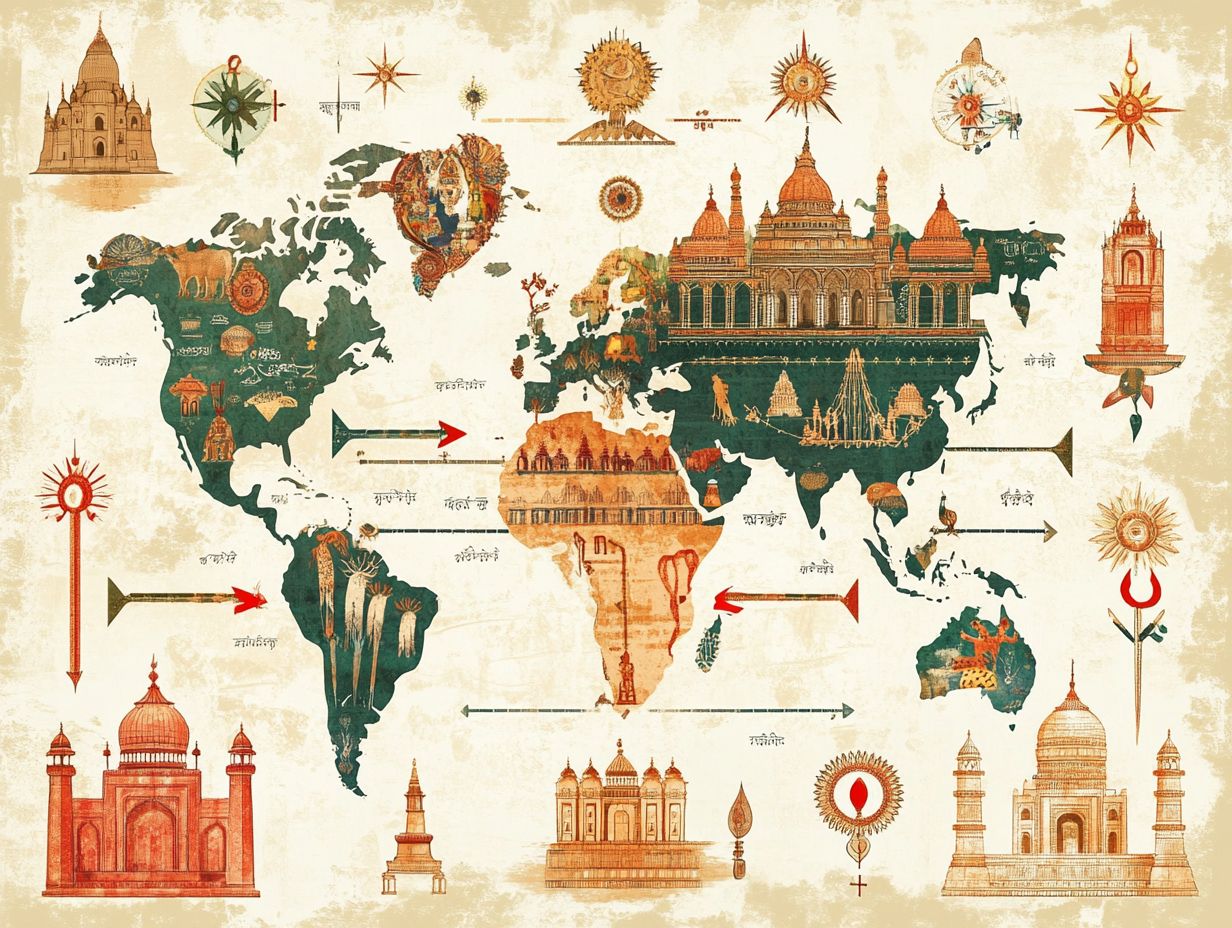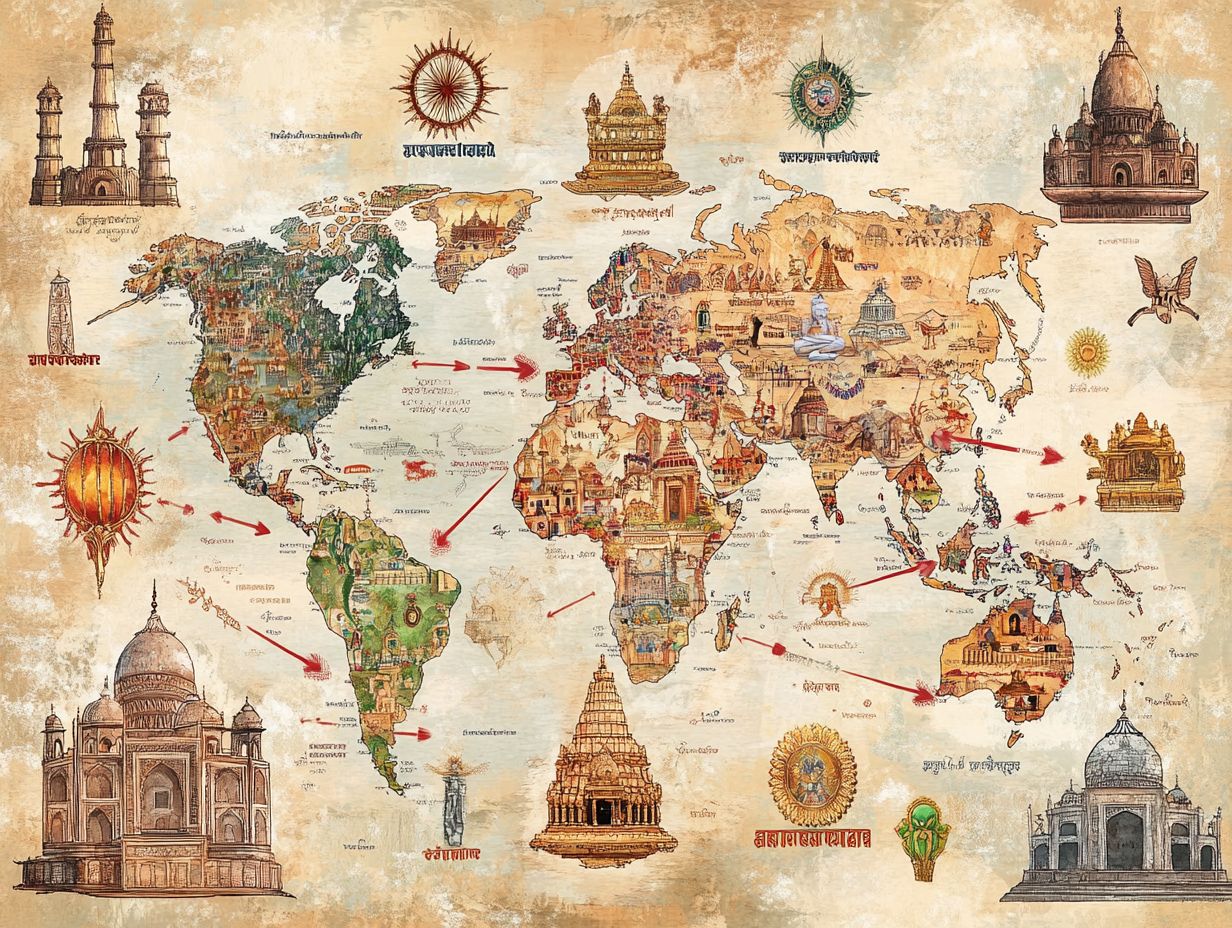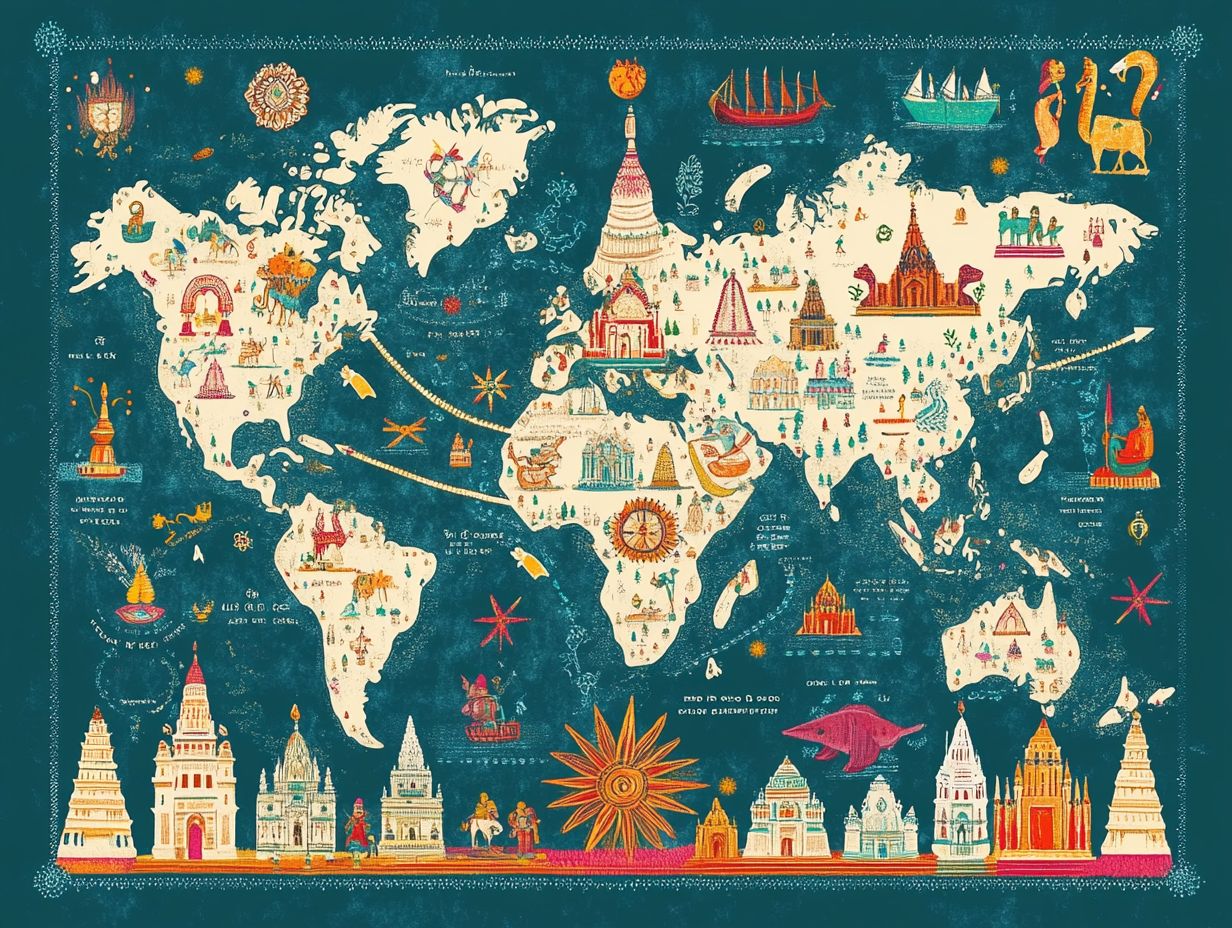How Did Relocation Diffusion Spread Hinduism?
Hinduism, recognized as one of the oldest religions in the world, boasts a rich history characterized by its expansion through relocation diffusion an intricate process whereby individuals carry their beliefs and practices to new territories, often leading to migration.
This exploration delves into how Hinduism transcended its geographic origins in India, identifying key factors that facilitated its widespread adoption, including the foundational Vedic tradition and the transformative Bhakti movement.
The examination of this faith encompasses its profound impact on diverse cultures, the challenges encountered during its journey, and its enduring influence in today’s interconnected global landscape, including diaspora communities.
Thus, the narrative reveals the captivating trajectory of Hinduism through the lens of relocation diffusion, illuminating a story of resilience, adaptation, and cultural diffusion.
What is Relocation Diffusion?

Relocation diffusion denotes the process through which cultural elements such as beliefs, traditions, and rituals are transmitted from one location to another as a result of the physical movement of people, reflecting the migration patterns of communities. This phenomenon frequently manifests within the context of migration, where communities relocate and carry their distinctive practices and spiritual heritages along with them. For more insight, explore how and why Hinduism spread.
The concept is essential for comprehending how religions like Hinduism have been disseminated across various geographical regions, contributing to demographic shifts and the formation of diverse diaspora communities.
As globalization progresses, the dynamics of relocation diffusion continue to evolve, intricately entwining with cultural exchange, adaptation, and assimilation.
How Did Hinduism Spread Through Relocation Diffusion?
Hinduism, recognized as one of the world’s oldest religions, has proliferated through the mechanism of relocation diffusion, intricately molded by migration patterns and the movements of the Indian diaspora.
This complex journey of religious dissemination can be traced to a myriad of influences, including established trade routes, the legacies of colonial history, and an enduring quest for improved opportunities beyond India s borders.
As Hindu communities established themselves in new locales, they carried with them their beliefs, traditions, and rituals, fostering a vibrant tapestry of cultural diffusion and adaptation across varied environments, often establishing temples and engaging in community rituals.
What are the Key Factors that Contributed to the Spread of Hinduism?
The global spread of Hinduism can be attributed to several pivotal factors, including migration, cultural exchange, and the broader influences of globalization. As members of the Indian diaspora established communities across various regions, they fostered a dynamic interplay of beliefs, traditions, and practices, enabling Hinduism to adapt and flourish within diverse cultural contexts.
This intricate process has been shaped by socio-economic factors, political environments, and the inherent desire for community cohesion, all of which have played essential roles in the international expression of Hindu practices, including spiritual practices like meditation and yoga.
Historical migrations, particularly during the British colonial era, significantly strengthened these communities, forging networks that spanned continents. Trade routes not only facilitated the exchange of goods but also allowed for the sharing of ideas, cultivating a sense of interconnectedness where Hindu philosophies found a receptive audience.
Intermarriage between individuals of Hindu descent and local populations further contributed to a unique blend of customs, enriching the faith while honoring local traditions.
Thus, the importance of community and cultural resilience emerges clearly as Hinduism evolves, demonstrating how adaptive practices enable it to thrive in an ever-changing world.
What are the Different Forms of Hinduism that Spread through Relocation Diffusion?
The various manifestations of Hinduism that have arisen through relocation diffusion exemplify the religion’s remarkable adaptability and the cultural influences of the regions it has permeated. These diverse forms, molded by local traditions and practices, frequently reveal elements of syncretism, where Hindu beliefs intertwine with indigenous customs and rituals.
From the ancient Vedic traditions to modern-day practices, each variation highlights the dynamic essence of Hinduism as it engages with a multitude of societal structures, ultimately contributing to a rich and vibrant cultural tapestry across the globe.
How Did the Vedic Tradition Spread through Relocation Diffusion?
The Vedic tradition, the bedrock of Hindu philosophy, disseminated through the process of relocation diffusion, as ancient texts and spiritual practices were carried forth by migrating communities across expansive geographical terrains, influencing regional variations in practices. As followers of the Vedic texts settled into new locales, they established places of worship, introduced rituals, and adapted their customs to harmonize with local cultures, thereby facilitating the religious expansion of Hinduism through various forms of spiritual practices.
This process exemplified the resilience and adaptability inherent in the Vedic tradition, allowing it to thrive within diverse environments while safeguarding its foundational teachings.
Through this vibrant exchange, local populations began to weave Vedic rituals into their own belief systems, resulting in a rich tapestry of practices that honored both indigenous customs and Vedic doctrines. The profound impact of sacred texts such as the Rigveda and the Upanishads continues to resonate in contemporary rituals and festivals, highlighting the enduring nature of ancient wisdom.
As communities intertwined, they exchanged not only spiritual beliefs but also philosophical concepts, which significantly influenced social structures and ethical values. This cultural dialogue laid the groundwork for the pluralistic society that defines modern Hinduism, illustrating that the essence of the Vedic tradition flourishes through its remarkable ability to evolve while remaining deeply rooted in its origins.
How Did the Bhakti Movement Spread through Relocation Diffusion?

The Bhakti movement, characterized by a profound devotion to personal deities and communal worship, proliferated through the process of relocation diffusion as devotees migrated and disseminated their spiritual practices across various regions, influencing local social structures. This grassroots initiative not only facilitated the expansion of Hinduism but also championed religious tolerance and inclusivity, inviting diverse ethnic groups to engage with its teachings and traditions, contributing to intercultural understanding.
As the movement wove its way through different cultural landscapes, it adeptly adapted to local customs while preserving its core beliefs, resulting in a rich tapestry of faith and community rituals.
Prominent figures such as Kabir, Mirabai, and Tulsidas not only inspired individuals through their poignant poetic compositions but also fostered communal gatherings that nurtured a sense of belonging among followers, promoting intercultural communication. These gatherings emerged as essential spaces for sharing stories, singing devotional songs, and discussing spiritual ideas, significantly bolstering the movement’s popularity.
Notably, the Bhakti movement s emphasis on personal experience and a direct connection to the divine allowed it to resonate across various social classes, leaving an indelible mark on local cultures and promoting a spirit of unity within diversity.
How Did the Spread of Hinduism through Relocation Diffusion Impact Different Cultures?
The spread of Hinduism through relocation diffusion has profoundly influenced numerous cultures, leading to distinctive adaptations, the emergence of cultural hybridization, and integration of Hindu festivals into local traditions. As Hindu communities established themselves in new regions, they frequently engaged in intermarriage and cultural exchange with local populations, creating a rich tapestry of traditions, customs, and spiritual practices, reinforcing cultural identity.
This dynamic process not only facilitated the flourishing of Hinduism but also contributed to the evolution of local identities and societal structures, fostering an environment characterized by multiculturalism and religious pluralism.
In regions such as Southeast Asia and the Caribbean, the fusion of Hindu rituals with indigenous beliefs has given rise to vibrant, locally-infused practices that honor their roots while embracing the uniqueness of the host culture.
As globalization continues to shape cultural interactions, the integration of Hindu festivals and culinary traditions into diverse societies exemplifies remarkable resilience and adaptability, enhancing intercultural dialogue. These exchanges often inspire cooperative worship and community-building, enabling Hinduism to play a significant role in promoting social cohesion across a variety of cultural landscapes.
What are the Challenges Faced in the Spread of Hinduism through Relocation Diffusion?
The dissemination of Hinduism through relocation diffusion presents a complex array of challenges, as communities grapple with the preservation of their cultural heritage while adapting to unfamiliar environments, often requiring community engagement and advocacy.
These challenges encompass navigating minority rights, addressing misconceptions, and safeguarding religious identity in the face of rapid globalization, modernization, and urbanization.
Moreover, the interplay between Hindu practices and local beliefs can create tensions, necessitating that communities strike a delicate balance between assimilation and the preservation of their cultural traditions to sustain their spiritual practices and heritage. This is particularly relevant in the context of migration and the formation of diaspora communities, where cultural preservation and adaptation are critical.
How Did Hinduism Adapt to Different Environments during Relocation Diffusion?
Hinduism has demonstrated remarkable adaptability as it has spread through relocation diffusion and cultural diffusion, allowing it to resonate with an array of cultural landscapes. As Hindu communities have migrated from India to other regions, they often integrate local customs and practices into their spiritual framework, resulting in unique adaptations of rituals, festivals, and beliefs.
This ability to adjust to new surroundings not only facilitates the acceptance of Hinduism across various regions but also enriches the religion, creating a more diverse expression of its core teachings found in sacred texts like the Vedas and Upanishads.
The process of adaptation is vividly illustrated by the incorporation of local deities and traditions, serving to bridge the gap between indigenous practices and Hindu beliefs. For instance, in regions like Southeast Asia, local customs merge with Hindu rituals to create vibrant festivals that emphasize community engagement, fostering a sense of belonging and shared identity among practitioners. This syncretism often leads to a dynamic and evolving expression of Hinduism.
Similarly, the celebration of Diwali varies from one locality to another, reflecting the influence of regional customs while preserving the festival’s essential themes of light and darkness. This ongoing dialogue between Hinduism and the cultures it encounters epitomizes the religion’s dynamic and evolving nature, showcasing its adaptability through cultural exchange and intercultural communication.
What Role did Trade and Travel Play in the Spread of Hinduism through Relocation Diffusion?
Trade and travel have been instrumental in the dissemination of Hinduism through the process of relocation diffusion, serving as vital conduits for cultural exchange and interaction. As traders and travelers navigated various regions, they did not merely exchange goods; they also shared profound ideas, beliefs, and spiritual practices that enriched the communities they encountered. These exchanges often involved the blending of belief systems and social structures.
This dynamic exchange facilitated the establishment of Hindu temples and places of worship in diverse locales, thereby solidifying Hinduism s presence and influence across a multitude of cultural settings. Temples became centers of community engagement and spiritual practices such as meditation and yoga.
The intricate web of trade routes, including the famed Silk Road and maritime passages, enabled the migration of not only commodities but also missionaries and learned scholars who carried Hindu philosophies and sacred texts to far-off lands.
These routes acted as arteries for vibrant dialogue between cultures, allowing for the seamless adaptation and integration of local traditions with Hindu practices. As a result, this cultural amalgamation led to the flourishing of dynamic Hindu communities, each developing its own unique identity while remaining connected to their roots.
Over time, these religious centers evolved into hubs of learning and devotion, contributing to a shared spiritual landscape spanning the regions influenced by Hinduism. They often housed schools where sacred texts like the Vedas and Upanishads were taught, furthering the religion’s educational and spiritual outreach.
What are the Modern Day Implications of Hinduism’s Spread through Relocation Diffusion?

The contemporary implications of Hinduism’s expansion through relocation diffusion highlight the complexities inherent in a multicultural society influenced by globalization and interconnectivity. As Hindu communities thrive across the globe, they weave a rich tapestry of beliefs, practices, and identities that enhance local cultures. The process often involves the integration of Hindu philosophy, ethics, and arts into the broader social fabric.
This continuous diffusion encourages meaningful dialogue among various religions and nurtures an understanding that transcends boundaries, ultimately fostering greater religious tolerance and pluralism within an increasingly interconnected world. This is particularly evident in diaspora communities, where intercultural dialogue and social cohesion are essential.
How Has Hinduism Influenced and Been Influenced by Other Religions through Relocation Diffusion?
Hinduism has both shaped and been shaped by other religions through the process of relocation diffusion, fostering rich interfaith dialogues and exchanges that reflect the intricate nature of spiritual beliefs. As Hindu communities established themselves alongside diverse religious groups, they engaged in meaningful cultural and spiritual interactions, which facilitated the blending of practices and philosophies. This often led to syncretism and the formation of unique belief systems.
This engagement has contributed to a broader understanding of faith and identity, further enriching Hinduism and cultivating tolerance among various ethnic groups and religions. Such cross-cultural interactions have also influenced Hindu rituals, festivals, and community practices, enriching the religion’s cultural tapestry.
Such interactions have resulted not only in the incorporation of diverse rituals and celebrations from different traditions but have also sparked deeper conversations about coexistence and mutual respect. By embracing the shared values of compassion and community that many faiths espouse, practitioners have nurtured an environment where interfaith dialogue flourishes, allowing for the cross-pollination of ideas that enhance spiritual practices. Concepts such as karma, dharma, and bhakti often become central topics in these interfaith dialogues.
This evolution of beliefs illustrates how cultural exchange weaves an intricate tapestry of religious understanding, forging connections that transcend individual doctrines while celebrating the essence of humanity’s quest for meaning. To explore this further, one can look into how Hinduism spread in India. The adaptation and integration of Hindu practices in various cultural contexts highlight the religion’s dynamic nature and its capacity for intercultural understanding.
What are the Controversies Surrounding the Spread of Hinduism through Relocation Diffusion?
The spread of Hinduism through relocation diffusion is fraught with controversy, particularly regarding cultural preservation and the safeguarding of religious identity. As Hindu communities acclimate to new environments, tensions frequently surface over the perceived dilution of traditional practices and the challenges of maintaining a cohesive identity in the face of globalization. These controversies often ignite discussions surrounding minority rights, the delicate balance between assimilation and cultural integrity, and the significance of Hindu organizations in addressing these pressing issues. The role of Hindu advocacy groups in preserving heritage and navigating assimilation challenges is pivotal in these contexts.
In numerous instances, these organizations act as essential conduits for support and advocacy, assisting members in navigating the intricate landscape of contemporary society while remaining firmly anchored in their heritage. Community reactions vary widely, reflecting a spectrum of perspectives on how to honor traditional beliefs and practices without alienating younger generations who are increasingly drawn to globalized lifestyles. The challenges of maintaining ethnic identity and cultural values in a rapidly changing world are central to these discussions.
This ongoing dialogue encapsulates the delicate interplay between preserving cultural values and embracing change, as stakeholders carefully consider their unique identities against the backdrop of an interconnected world, thereby reshaping their understanding of what it means to belong to the Hindu community in today’s context. These discussions often involve considerations of social networks, transnational networks, and the role of social media in maintaining community ties.
Frequently Asked Questions
What is relocation diffusion?
Relocation diffusion is the process by which a cultural trait or idea spreads from one place to another through the movement of people, often involving population movement and migration patterns.
How did relocation diffusion spread Hinduism?

Hinduism spread through relocation diffusion as followers of the religion migrated to new areas, bringing their beliefs and practices with them. This often involved the establishment of Hindu communities and the building of temples in new regions.
Were there any specific groups or individuals responsible for the relocation diffusion of Hinduism?
Yes, the Aryans are believed to have played a significant role in the relocation diffusion of Hinduism. They migrated from Central Asia to the Indian subcontinent and brought their religious traditions with them, which were eventually codified in the Vedas and other sacred texts.
Did Hinduism spread through relocation diffusion quickly?
No, the spread of Hinduism through relocation diffusion was a gradual process that took place over centuries as people migrated and settled in different regions. This gradual spread allowed for significant regional variations in customs and practices.
What other factors besides relocation diffusion contributed to the spread of Hinduism?
Hinduism also spread through expansion diffusion, where ideas and practices were adopted by neighboring cultures, as well as through missionary activities, trade routes, and social networks.
How did the spread of Hinduism through relocation diffusion impact the religion?
The spread of Hinduism through relocation diffusion led to the development of different sects and branches within the religion as it adapted to new cultural influences and practices in different regions. This process often involved the blending of local myths, legends, and sacred geography with traditional Hindu beliefs.
